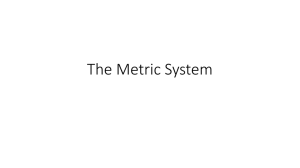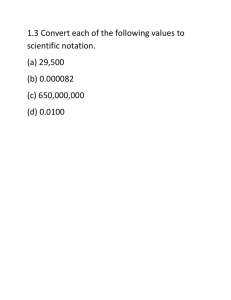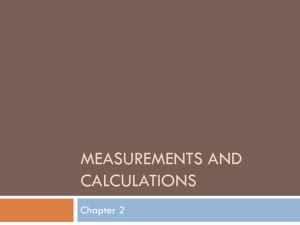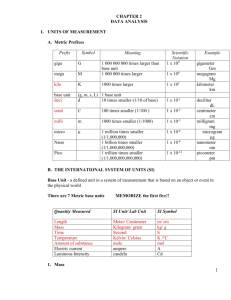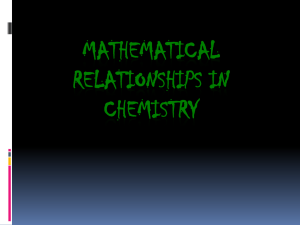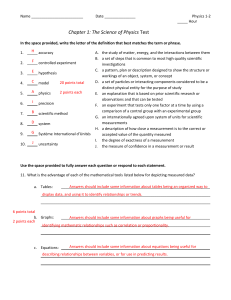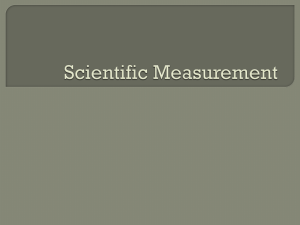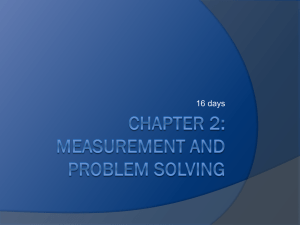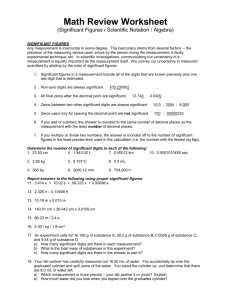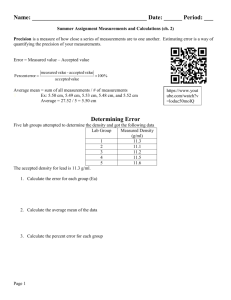lecture notes on Chapter 1 in PowerPoint Format.
advertisement
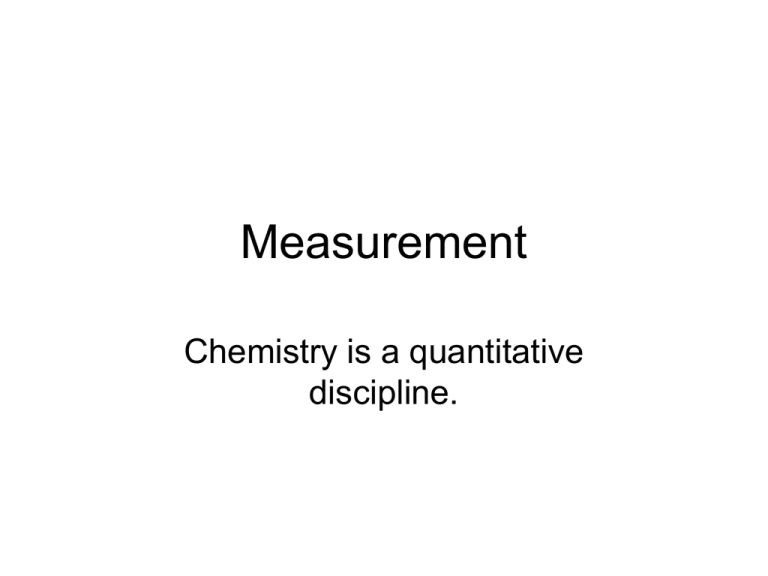
Measurement Chemistry is a quantitative discipline. Significant Figures • The numerical value of every observed measurement is an approximation. The accuracy of every measurement is limited by the accuracy of the measuring instrument. The last digit is an estimated figure and is considered significant. • Some numerical values are considered to be exact and have as many significant digits as desired. These are usually conversion factors specified by definition, e.g., 1 kg = 1000 g. Zeros as significant figures • Embedded zeros are significant – 1008 has four significant figures. • Leading zeros used as place holders are not significant. 0.0028 has two significant figures. • Trailing zeros may or may not be significant depending on the decimal point. 1500 has two significant digits. 87.60 has four significant digits. 650. has three significant digits. Arithmetic and Significant Figures • Adding and subtraction – the answer should be rounded off after adding or subtracting so as to retain digits only as far as the column with the lowest accuracy. • Multiplication and division – the answer should be rounded off to contain only as many significant figures as contained in the least exact factor. Example • Add the following 156.67 90.124 432.098 Divide the following: 45.67 / 80.2 Scientific Notation • Scientific notation – method used to succinctly and accurately write very large or very small numbers. • Standard format – • m.mmm x 10power • m.mmm is a number and < 10 • power is an integer (whole number that may be positive, negative, or zero) • We will see later that this format works well with evaluating logarithms. Also the number of significant figures is fully expressed in the leading factor. Example • Convert 0.000 145 to scientific notation. • Covert 7,789,000 to scientific notation. • Multiply these two numbers in scientific notation form and convert back to regular notation. Example • Convert 6.30 x 10-3 to standard decimal form. • Convert 8.998 x 105 to standard decimal form. Measurement Units • All of the sciences use the metric system (SI system) • SI system originally developed in France in the French Revolution and spread throughout Europe by Napoleon Bonaparte. Fundamental Units and Measures • • • • • Length – meter (about 7% longer than a yard) Volume – liter (about 6% larger than a quart) Mass – kilogram (about 2.2 pounds) Time – second (no difference) Temperature – Celsius degree (1.8 of a Fahrenheit degree). Same magnitude as a Kelvin degree, but different zero points. • Note: 1 liter = 1000 cm3 and that 1 ml = 1 cm3 Metric units • All metric units are based on making multiples or fractions based on 10. It is a decimal system – like money. • Prefixes on the base unit indicate the multiple or fractional nature of the quantity. • Multiples (using Greek) – • deka (10), hecto (100), kilo (1000), mega (1,000,000) • Fractions (using Latin) – • deci (0.1), centi (0.01), milli (0.001), micro (0.000001) Conversion of Units • Use factor-label method (a.k.a. dimensional analysis) • One goes from a given unit to the desired unit by multiplying by a fraction called the unit-factor in which the numerator and the denominator represent the same quantity. • For example, we are given that 2.54 cm is one inch (exactly). To convert from inches to cm, we multiply by the factor • 2.54 cm / 1 inch. • To convert from cm to inches, we multiply by • 1 inch / 2.54 cm. Example • Convert 5.00 inches to centimeters. Example • A tourist goes shopping in Austria and purchases items totaling 135 euros. How many dollars is this purchase? (assume that $1 = 0.75 euro) Example • What is the weight in grams of seven nails when the nails weigh 0.765 kg / gross? Example • Find the capacity in liters of a tank 0.6 m long, 10 cm wide, and 50 mm deep. Temperatures • Scientific temperatures are recorded in either Celsius or Kelvin temperatures, not Fahrenheit. 5 • Formulae TC (TF 32) 9 TF 1.8TC 32 TK TC 273.15 Example • You are in Wisconsin in January and it is -20 oF at a bus stop. What is the temperature in oC? Example • The boiling point of a liquid is found to be 67 oC. What is this temperature in Fahrenheit and in Kelvin? Density • For solids and liquids, usually expressed as grams / cm3 or grams / milliliter. • Density expresses a unit conversion factor. • Density of mercury is 13.6 g / cm3 • This means that 13.6 g Hg describes the same quantity as 1 cm3 of Hg. Both the numerator and denominator describe the same quantity. Example • Battery acid has a density of 1.285 g / cm3 and contains 38.0% by weight sulfuric acid. How many grams of pure sulfuric acid are contained in a liter of battery acid? Example • A preparation of concentrated nitric acid is 69.8% by weight pure nitric acid. It has a density of 1.42 g / cm3. What volume of the concentrated acid contains 63.0 g of pure nitric acid?
